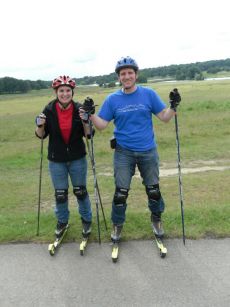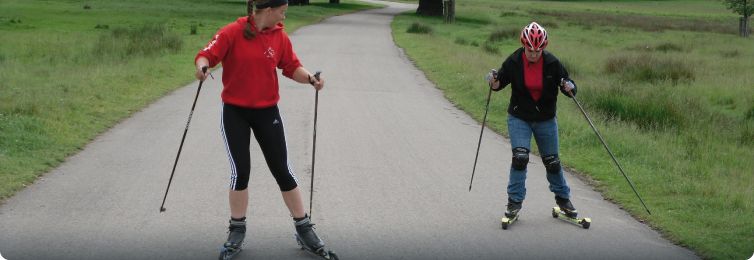Sport of the Month London Roller Ski
It combines rollerblading and cross country skiing. Though it does not get a lot of attention in the UK, roller skiing is popular among cross country skiers and in the Nordic countries. The TotallySporty Team got the chance to experience roller skiing first hand from Flic, a rollerski.co.uk instructor. With thoughts of how difficult it will be already swimming around in our minds, the TS team geared up and was pleasantly surprised to find how painless and fun roller skiing really is.
Rollerskiing started as an activity that cross-country skiers did in the off season. Roller skiing is a combination of rollerblading and cross-country skiing. Participants gear up with poles, skates, helmets, pads, gloves and boots. The skate wheels are similar to wheels on rollerblades, thus the terrain needed is the same as for rollerblading. Rollerskiing on tarmac works the best, though there are all-terrain skis.
There are two different types of rollerskiing: skate and classic. Skate is a faster kind of roller skiing that consists of V type movements. Classic is based on the traditional form of cross-country skiing, where the skis run parallel and you stride forward. The 'grip' (which stops one ski from sliding back) is provided by a one-way ratchet wheel, which replicates the grip wax or skins used on snow. The poles used help incorporate the upper body into the workout and are used for momentum.
Anyone can rollerski, it is a sport for everyone. It can be a serious sport by participating in racing or it can be more leisurely by rollerskiing in parks whenever you have a free moment. Age doesn’t matter in the sport. Though there are no prerequisite activities to participate, cycling, rowing, running and swimming are all good transition sports. Cycling and rowing are the best in terms of transferrable skills. Rollerblading, ice skating and other balance sports are also very helpful when beginning rollerskiing.
There are numerous benefits to rollerskiing. As with any sport or exercise routine, there are both physical and mental benefits to participating. Rollerskiing is a four limb exercise, meaning that it works all four limbs creating a very thorough workout. The use of the poles helps to flatten your stomach and work the latissimus dorsi muscles, or the back muscles. Rollerskiing is a good way to lose weight as well.
Rollerskiing is always smoother on your joints than some other exercises, like running. It is a low-impact exercise, which makes it easy and accessible to everyone, even people that have had injuries before or are recovering from injury.
Rollerskiing creates a personal challenge for people, so it is a rewarding sport when participants reach their goals. It also helps to build confidence because participants actually see their progression.
Progression is different for each individual. Different people progress over different periods of time. Participants will start by balancing. They will then see how far they can go and eventually set a personal goal for themselves. The goal could be racing, prepping for a ski marathon or moving to snow.
Rollerski.co.uk has weekly beginner training sessions in both Richmond Park and Hyde Park. They meet in Richmond Park on Wednesday evenings and Hyde Park on Saturday mornings. They also offer 1-day, 4-week and 6-week courses. They have beginner courses being offered in Hyde in June, September and November (skating) as well as in September, October and November (classic). For more information go to the rollerski.co.uk website. Classes usually have around 8 to 10 people in each. There are also classes offered at Dorney Lake near Windsor.
If you would like to buy your own kit, they run around £300 and club fees are around £30-35, which includes a training session a week, hiring equipment, among other things. You can even buy your kit from rollerski.co.uk.
For further information about the sport and how to get involved, go to www.rollerski.co.uk or visit the Snowsport England website, the national authority on rollerskiing, at www.snowsportengland.org.uk.
What is roller skiing?
Rollerskiing started as an activity that cross-country skiers did in the off season. Roller skiing is a combination of rollerblading and cross-country skiing. Participants gear up with poles, skates, helmets, pads, gloves and boots. The skate wheels are similar to wheels on rollerblades, thus the terrain needed is the same as for rollerblading. Rollerskiing on tarmac works the best, though there are all-terrain skis.
There are two different types of rollerskiing: skate and classic. Skate is a faster kind of roller skiing that consists of V type movements. Classic is based on the traditional form of cross-country skiing, where the skis run parallel and you stride forward. The 'grip' (which stops one ski from sliding back) is provided by a one-way ratchet wheel, which replicates the grip wax or skins used on snow. The poles used help incorporate the upper body into the workout and are used for momentum.
Anyone can rollerski, it is a sport for everyone. It can be a serious sport by participating in racing or it can be more leisurely by rollerskiing in parks whenever you have a free moment. Age doesn’t matter in the sport. Though there are no prerequisite activities to participate, cycling, rowing, running and swimming are all good transition sports. Cycling and rowing are the best in terms of transferrable skills. Rollerblading, ice skating and other balance sports are also very helpful when beginning rollerskiing.
Why should I participate?
There are numerous benefits to rollerskiing. As with any sport or exercise routine, there are both physical and mental benefits to participating. Rollerskiing is a four limb exercise, meaning that it works all four limbs creating a very thorough workout. The use of the poles helps to flatten your stomach and work the latissimus dorsi muscles, or the back muscles. Rollerskiing is a good way to lose weight as well.
Rollerskiing is always smoother on your joints than some other exercises, like running. It is a low-impact exercise, which makes it easy and accessible to everyone, even people that have had injuries before or are recovering from injury.
Rollerskiing creates a personal challenge for people, so it is a rewarding sport when participants reach their goals. It also helps to build confidence because participants actually see their progression.
Progression is different for each individual. Different people progress over different periods of time. Participants will start by balancing. They will then see how far they can go and eventually set a personal goal for themselves. The goal could be racing, prepping for a ski marathon or moving to snow.
How do I get started in London?
Rollerski.co.uk has weekly beginner training sessions in both Richmond Park and Hyde Park. They meet in Richmond Park on Wednesday evenings and Hyde Park on Saturday mornings. They also offer 1-day, 4-week and 6-week courses. They have beginner courses being offered in Hyde in June, September and November (skating) as well as in September, October and November (classic). For more information go to the rollerski.co.uk website. Classes usually have around 8 to 10 people in each. There are also classes offered at Dorney Lake near Windsor.
If you would like to buy your own kit, they run around £300 and club fees are around £30-35, which includes a training session a week, hiring equipment, among other things. You can even buy your kit from rollerski.co.uk.
Further information on roller skiing
For further information about the sport and how to get involved, go to www.rollerski.co.uk or visit the Snowsport England website, the national authority on rollerskiing, at www.snowsportengland.org.uk.



